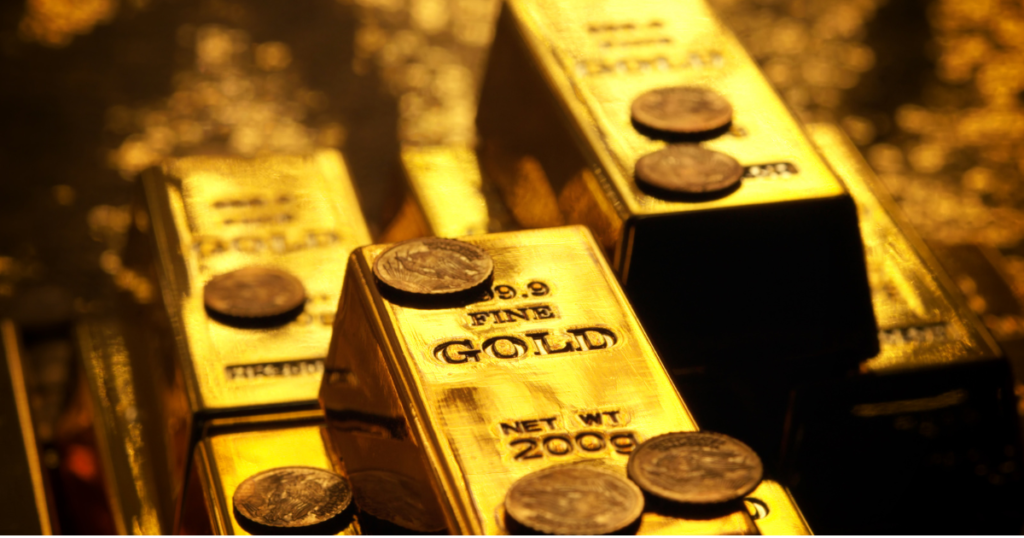Gold prices have reached all-time highs, spurred, in part, by a surge in demand over the past year. Currently trading above $2,250 per ounce, gold has already exceeded JPMorgan’s earlier forecasts for the year, prompting many to speculate about its future value trajectory. While it’s impossible to predict the market with certainty, this article offers our expert insights and practical advice to help you capitalize on this upward trend in your investment strategy.
First, let’s explore how the price of gold reached this point.
Why is the Price of Gold So High?
The price of gold today can be attributed to many factors that highlight its role as both a hedge and a haven in volatile markets. Here’s a closer look at the key elements driving gold to its current heights:
- Inverse Relationship with the U.S. Dollar: Gold prices often move inversely to the U.S. dollar. Recently, the dollar has weakened amid uncertainties about the Federal Reserve’s interest rate decisions. This weakening has significantly contributed to the rise in gold prices, as gold becomes a more attractive investment than the depreciating dollar.
- Expectations of Federal Reserve Rate Cuts: The anticipation of lower interest rates is a central theme in the current economic climate. Federal Reserve Chair Jerome Powell’s recent hints at possible rate cuts later this year have fueled optimism in the gold market. Since gold doesn’t yield interest, lower interest rates decrease the opportunity cost of holding gold versus yield-bearing assets.
- Decreasing Bond Yields: As the yields on 10-year Treasury notes have fallen significantly from their peaks, decreasing by 17.6%, investors are turning to alternative assets. With its non-yield nature, gold becomes an attractive option for those looking for better returns than bonds currently offer.
- Geopolitical Tensions: Ongoing conflicts like those in Ukraine and Gaza enhance gold’s appeal as a safe-haven asset. In times of geopolitical uncertainty, gold is traditionally seen as a secure store of value, which increases its demand and, consequently, its price.
- Central Bank Buying Activity: A primary reason for the rise in gold prices is the strong buying activity by central banks, especially China’s significant purchases since 2022. This trend continued into 2024, with central banks increasing their gold reserves significantly, driving demand and increasing prices.
These varied yet interconnected factors explain why gold prices have reached their current levels. But will the upward trend continue?
The Future of Gold Prices
Our forecasts for the precious metals market have been spot-on. Gold reached new highs in 2024 and is already hitting our projected target of $2,300 per ounce by mid-year. What can we expect for the remainder of the year—and beyond? In the short term, experts anticipate that gold prices will hold steady. This stability is influenced by the Federal Reserve’s decision to maintain higher interest rates over the next few months. Longer-term, the outlook remains bullish. A recent JPMorgan report suggests that gold prices will continue to rise quarter-over-quarter, potentially peaking in the latter half of 2025. This expected increase originates from the anticipated Federal Reserve rate cuts and ongoing geopolitical tensions, which bolster gold’s status as a safe-haven asset. These factors will likely attract more investors to gold during global uncertainty.
How to Buy and Sell Gold
If you’re looking to hedge against inflation or diversify your portfolio, consider these gold investment options:
- Physical Gold: This option includes bars and coins, with secure storage and insurance to safeguard your investment.
- Gold IRAs: These allow you to diversify your retirement portfolio and come in different forms, including traditional, Roth, and SEP IRAs, each offering distinct tax benefits.
- Gold Futures: These are speculative and carry higher risks, making them more suitable for experienced investors.
- Gold ETFs and Mining Stocks: These investments provide exposure to gold prices and the performance of mining companies, linking your returns to both the commodity and equity markets.
It’s important to view investing in gold as a protective measure against market volatility rather than a primary growth strategy. Experts recommend limiting gold investments to only 5% to 10% of your portfolio to maintain proper diversification.
Interested in capitalizing on the current high price of gold? Consider selling your gold jewelry, coins, bars, and other items. Start with a professional jewelry or coin appraisal to determine the fair market value of your pieces. Choosing a reputable buyer is crucial to ensure you receive a fair return on your investment.
Your Gold Experts
At our family-owned and operated jewelry store in Bucks County, we specialize in guiding you through the complexities of buying and selling gold in Doylestown. Whether you’re attracted to gold as an investment or liquid asset, we are dedicated to helping you navigate the market to buy or sell gold at the best prices. Contact us or stop in our store to learn how we can assist you with your gold investment and selling needs.


